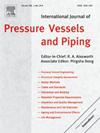Experimental investigation on leakage localization in water pipeline based on IGWO-VMD and hybrid neural network
IF 3
2区 工程技术
Q2 ENGINEERING, MECHANICAL
International Journal of Pressure Vessels and Piping
Pub Date : 2025-05-30
DOI:10.1016/j.ijpvp.2025.105564
引用次数: 0
Abstract
Water pipelines are highly susceptible to leakage, which can lead to safety hazards, economic losses, and environmental damage. To detect leakage losses, an experimental study is conducted to collect a dataset of 969 pressure signals, including leakage, stability, and interference signals. The results show that as the volume flow decreases and the distance between the leakage point and the sensor increases, the signal strength significantly attenuates. This attenuation reduces the distinguishability of leakage signals—especially under noisy conditions, where noise may even obscure the leakage features—thereby increasing the difficulty of accurate localization. To mitigate noise in signals, this paper proposes an adaptive denoising algorithm (IGWO-VMD) based on variational mode decomposition (VMD) and an improved grey wolf optimizer (IGWO), which effectively suppresses noise and enhances leakage features. In addition, to achieve accurate leakage localization in the presence of interference signals—such as valve closures that closely resemble leakage signals—a hybrid neural network combining temporal convolutional networks (TCN) and bidirectional long short-term memory (BiLSTM) is proposed. This model exhibits strong feature extraction capabilities and robust performance in complex signal environments, effectively reducing the risk of misjudgment. Comparative evaluations with state-of-the-art methods across multiple performance metrics show that the model accurately identifies leakage signals and precisely localizes leakage positions, demonstrating its potential as a reliable solution for intelligent water pipeline management.
基于IGWO-VMD和混合神经网络的输水管道泄漏定位实验研究
输水管道极易发生泄漏,造成安全隐患、经济损失和环境破坏。为了检测泄漏损失,我们进行了一项实验研究,收集了969个压力信号数据集,包括泄漏、稳定和干扰信号。结果表明,随着体积流量的减小和泄漏点与传感器之间距离的增大,信号强度明显衰减。这种衰减降低了泄漏信号的可识别性,特别是在噪声条件下,噪声甚至可能掩盖泄漏特征,从而增加了准确定位的难度。为了降低信号中的噪声,本文提出了一种基于变分模态分解(VMD)和改进的灰狼优化器(IGWO)的自适应去噪算法(IGWO-VMD),该算法有效地抑制了噪声,增强了泄漏特征。此外,为了在存在干扰信号(如与泄漏信号非常相似的阀门关闭信号)的情况下实现准确的泄漏定位,提出了一种结合时间卷积网络(TCN)和双向长短期记忆(BiLSTM)的混合神经网络。该模型在复杂信号环境下具有较强的特征提取能力和鲁棒性,有效降低了误判风险。通过多个性能指标与最先进的方法进行比较评估,表明该模型能够准确识别泄漏信号,并精确定位泄漏位置,证明了其作为智能供水管道管理可靠解决方案的潜力。
本文章由计算机程序翻译,如有差异,请以英文原文为准。
求助全文
约1分钟内获得全文
求助全文
来源期刊
CiteScore
5.30
自引率
13.30%
发文量
208
审稿时长
17 months
期刊介绍:
Pressure vessel engineering technology is of importance in many branches of industry. This journal publishes the latest research results and related information on all its associated aspects, with particular emphasis on the structural integrity assessment, maintenance and life extension of pressurised process engineering plants.
The anticipated coverage of the International Journal of Pressure Vessels and Piping ranges from simple mass-produced pressure vessels to large custom-built vessels and tanks. Pressure vessels technology is a developing field, and contributions on the following topics will therefore be welcome:
• Pressure vessel engineering
• Structural integrity assessment
• Design methods
• Codes and standards
• Fabrication and welding
• Materials properties requirements
• Inspection and quality management
• Maintenance and life extension
• Ageing and environmental effects
• Life management
Of particular importance are papers covering aspects of significant practical application which could lead to major improvements in economy, reliability and useful life. While most accepted papers represent the results of original applied research, critical reviews of topical interest by world-leading experts will also appear from time to time.
International Journal of Pressure Vessels and Piping is indispensable reading for engineering professionals involved in the energy, petrochemicals, process plant, transport, aerospace and related industries; for manufacturers of pressure vessels and ancillary equipment; and for academics pursuing research in these areas.

 求助内容:
求助内容: 应助结果提醒方式:
应助结果提醒方式:


